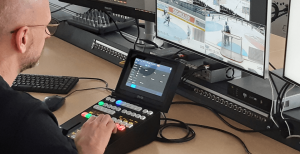SVG Tech Insight: Moving Towards Live Production Anywhere in the Post-COVID Era
This fall SVG will be presenting a series of White Papers covering the latest advancements and trends in sports-production technology. The full series of SVG’s Tech Insight White Papers can be found in the SVG Fall SportsTech Journal HERE.
Sports broadcasters today are challenged to produce more content more efficiently while coping with shrinking budgets. Traditional live production as we have known it for many decades, where all primary equipment and staff are located at the production site, is making way for alternative models to better adapt to the new realities of the industry. Remote production, for instance, is known to create more efficient workflows for the coverage of live events and is changing the way crews collaborate. And while the ability to produce an event from a distance is not new, it has gained momentum over the past few years and has become more relevant than ever since the COVID-19 outbreak.
The 2020 ‘operator at home’ production model
There are different types of remote production, and the terminology can have different meanings depending on who you talk to. However, it is generally agreed that ‘remote production’ is the overarching term that describes a production with some elements of the production happening remotely from another element. It can be broadly categorized into different approaches including distant remote, centralized, or distributed, depending on where the staff, equipment, and facilities are located.
Prior to the coronavirus outbreak, remote production was mostly synonymous with centralized production, sometimes referred to as ‘Home-Run’ or ‘At-Home’ production. It was the most widespread of these approaches, referring to setups where a majority of the equipment and staff are housed in a broadcast center for a production separate to the venue where the event is taking place.
Broadcasters using this model before the pandemic already reported a number of benefits; it greatly reduces travel expenses, since fewer people and less equipment are needed at the venue. In turn, less travel means a reduced carbon footprint for a more environmentally friendly way to produce live events. Additionally, remote production means more games can be covered in a shorter period of time. By spending less time on the road, operators are able to produce back-to-back games (perhaps even in the same day) or work on a wider variety of sports. This allows operators to rapidly gain new skills and experiences, leading to smoother, higher-quality productions.
When the coronavirus swept the world, broadcasters were thrown into the deep end of remote production. The travel restrictions and social distancing measures brought by the pandemic meant crews needed to be shifted away as much as possible from studios and centralized production facilities. Despite the little time they had to prepare, many broadcasters found new and creative ways to adapt their existing setups on the fly, allowing parts of their production crews to work from the safety of their own homes. By creating distributed remote workflows, businesses were able to continue producing and delivering content while helping contain the spread of the virus. Almost overnight, this ‘operator at home’ production model became the prevalent form of remote production, and the only way to get programs back on air safely.
Overcoming the remote production fear factor
It’s fair to say that sports productions are among the most severely hit by the pandemic; while newsrooms and talk shows have been able to more easily adapt their formats and find solutions and workarounds to continue their programming with little disruption, it’s the entire sports business model that has been affected by the blank sports calendar. But, despite being hit harder by the crisis, the absence of live games has also given them the opportunity to take a step back and start rethinking their production models for the better.
Before COVID-19, transitioning to remote workflows was an intimidating process for many. Perhaps because remote workflows were not routinely used for complete productions of tier-1 or primetime live sports events, but rather, as an add-on or expansion of traditional production methods. In lower tier sports where it could be considered less was at stake, it was more regular. Broadcasting equipment and technology also represent significant investments, and the prospect of making substantial transformations to already established production infrastructures was a daunting prospect.
This widespread adoption of remote workflows during the crisis has showed the entire industry — including sports broadcasters — that remote production is well and truly a viable option and that the transition towards this model doesn’t necessarily mean having to perform a complete overhaul of existing infrastructures. The core ingredients exist today for broadcasters to easily complement their current production setups to accommodate (or better support) remote workflows while capitalizing on their current investments. The fear factor has finally been removed.
A stepping stone to live production anywhere
As we emerge from this crisis, it has become clear is that it will be important for sports broadcasters to take note from the industry’s recent achievements and continue to adapt their infrastructures for a better support of remote workflows in the long run.
By leveraging IP-based toolsets, software-defined technologies, and cloud-based solutions, broadcasters can seamlessly move towards production models where location is no longer a constraint. At the end of the day, whether it’s REMI, GREMI, centralized, at home or distant remote, what you want to achieve is live production anywhere.
As an example, the replay element of a broadcast usually represents multiple operators in a confined environment, but with replay systems that exist in the market today, operators can work from literally anywhere, providing there is a secure IP connection. They can conveniently set up the replay controller and a multiviewer either in the broadcast center, or from the comfort of their own homes, connect to a server deployed at the event location, and begin working immediately. They can build their replay and highlights packages from a distance, sometimes even thousands of miles away, in a similar way to how they would do back at the venue.
Another possible scenario is moving the servers away from the event site, back into the main production facility. This allows the creation of live programming with minimum equipment and staff at the event site, since most operations are done from a distance.
This client-server decoupling is not limited to replay systems. There are review systems (VAR), all-in-one production systems, and live switchers that also rely on this type of architecture, allowing operators to work from anywhere, at any time.
Content management from different sites is also possible. With natively web-based tools, as well as other technologies such as remote desktop and PC over IP technology (PCoIP), production staff can manage ingest, metadata, and clipping, as well as playout from any location.
By further exposing the fragility of traditional approaches, the challenges brought by COVID-19 have strengthened the idea that remote production will play a central role in the future of live production. As we move forward, we can expect to see improvements in today’s tools and technologies and an acceleration of innovations that will bring the future live remote production experience to the highest level with crews collaborating live, from anywhere.



